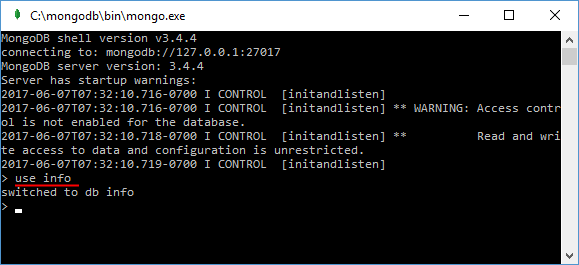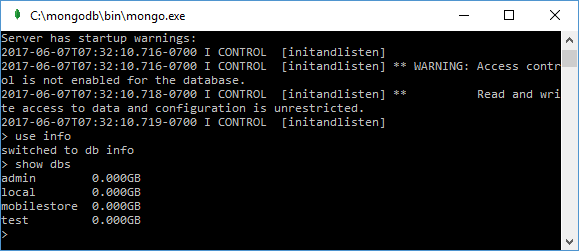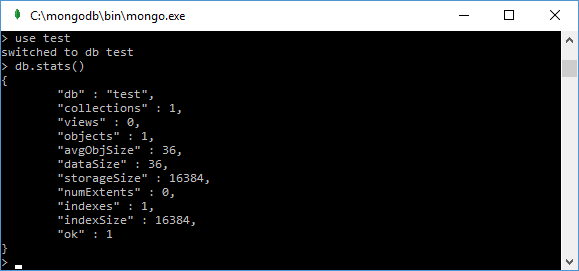Preamble

When you start working with MongoDB Database, the first thing you need to do is to install the database we need as a current database in order to use it later.
To do this, use the use command followed by the database name. It does not matter whether such a database exists or not.
If it does not exist, the MongoDB shall automatically create it when adding data to it. For example, let us run mongo.exe and enter the following command there:
> use info

Now the info database will be installed as the current one.
If you are suddenly unsure whether a database with such name already exists, you can use the command show DBS to display the names of all available databases on the console:

Any name can be set for the database, but there are some limitations. For example, the name shall not contain the characters /, \, ., “, *, <, >, :, |, ?, $. In addition, database names are limited to 64 bytes.
There are also reserved names that cannot be used: local, admin, config.
And as you can see, dd info is not in this list, because I have not yet added data to it.
If we want to know which dd is currently used, we can use the db command:
db
info
In addition to databases, we can view a list of all collections in the current database using the show collections command. However, since the database, which is specified in the current database, does not exist yet, it does not contain any collections.
Getting statistics
The db.stats() command shall be used to obtain statistics for the current database. For example, we have a test installed as the current one:

In a similar way, we can learn all the statistics for a particular collection. For example, we can find out the statistics for the users: db.users.stats() collection.
MongoDB Administration Tutorial: MongoDB Tutorial & MongoDB Administration Training
Enteros
About Enteros
IT organizations routinely spend days and weeks troubleshooting production database performance issues across multitudes of critical business systems. Fast and reliable resolution of database performance problems by Enteros enables businesses to generate and save millions of direct revenue, minimize waste of employees’ productivity, reduce the number of licenses, servers, and cloud resources and maximize the productivity of the application, database, and IT operations teams.
The views expressed on this blog are those of the author and do not necessarily reflect the opinions of Enteros Inc. This blog may contain links to the content of third-party sites. By providing such links, Enteros Inc. does not adopt, guarantee, approve, or endorse the information, views, or products available on such sites.
Are you interested in writing for Enteros’ Blog? Please send us a pitch!
RELATED POSTS
How Enteros Transforms Healthcare Cost Management with AI Financial Intelligence and Database Performance Optimization
- 4 December 2025
- Database Performance Management
Introduction The healthcare sector is facing unprecedented financial and operational pressure. As medical organizations modernize their IT environments—embracing AI-driven diagnostics, telemedicine platforms, electronic health record (EHR) systems, imaging repositories, and cloud-native applications—the cost of operating these digital workloads continues to surge. At the same time, inefficiencies within databases, data pipelines, clinical software platforms, and analytics … Continue reading “How Enteros Transforms Healthcare Cost Management with AI Financial Intelligence and Database Performance Optimization”
Optimizing Retail Digital Operations: Enteros AI Platform for Accurate Cost Estimation and Superior Performance Management
Introduction The retail sector is undergoing one of the fastest digital transformations in history. From omnichannel commerce and predictive analytics to inventory automation and personalized customer experiences, today’s retail enterprises depend on complex, high-volume digital systems. These systems—spanning eCommerce platforms, databases, cloud services, POS solutions, and logistics software—process massive real-time workloads that directly influence customer … Continue reading “Optimizing Retail Digital Operations: Enteros AI Platform for Accurate Cost Estimation and Superior Performance Management”
How Technology Teams Improve Performance Management with Enteros’ AIOps and AI-First Operations Framework
- 3 December 2025
- Database Performance Management
Introduction The technology sector is undergoing a rapid transformation as cloud-native architectures, SaaS ecosystems, and real-time data systems redefine how organizations operate. Yet with this digital acceleration comes an overwhelming surge in complexity — distributed microservices, multi-cloud deployments, AI-augmented workflows, and massive data pipelines that demand precision, speed, and resilience. To navigate this complexity, enterprises … Continue reading “How Technology Teams Improve Performance Management with Enteros’ AIOps and AI-First Operations Framework”
The Future of Healthcare Databases: Enteros’ GenAI and AI Performance Management at Work
Introduction The healthcare sector is undergoing a digital revolution unlike anything seen before. From AI-assisted diagnostics and precision medicine to telehealth platforms and clinical research systems, today’s healthcare organizations rely heavily on massive data ecosystems. Databases power everything — electronic health records (EHRs), patient management systems, revenue cycle applications, insurance claim platforms, imaging archives, and … Continue reading “The Future of Healthcare Databases: Enteros’ GenAI and AI Performance Management at Work”